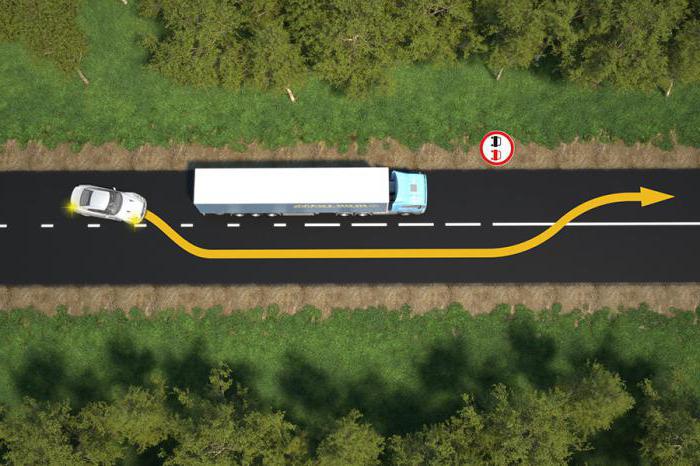What is overtaking and what is considered a violation of traffic rules?
Overtaking is by far the most dangerous of the maneuvers,which the driver can carry out while driving on the vehicle. Despite the simplicity of this concept, not all drivers understand its meaning. Let's figure out what overtaking is and how to carry it out so that no one is hurt! Let's start with the terminology.
What is overtaking and how does it differ from the lead?
Before proceeding to the review of the basic rulesLet's define the terms. So, overtaking is a maneuver, connected with the departure to the oncoming traffic, in order to advance another vehicle, with the subsequent return to the previously occupied lane. Many drivers confuse such concepts as overtaking and advancing, which often leads to problems with representatives of the law.

An advance is the movement of a car at a speed greater than that of a passing vehicle.
Thus, overtaking is a special caseahead, but the lead is not always overtaking. The main distinguishing feature of overtaking is the exit to the oncoming lane. It is relevant in the event that the road has one lane in each direction. If there are two or more bands, there is always an opportunity to advance, without resorting to a trip to the oncoming lane.
Previously, there was a rule that sounded as followsway: "Overtaking is allowed only on the left side". It is absolutely not logical, since there can not be a counter-strip on the right side. This rule was used by unscrupulous representatives of the traffic police, fining the inexperienced drivers for getting ahead of the right lane and giving it out for an incorrect overtaking.
Advance is a much safer maneuver than overtaking, so it is permitted almost always. And now let's look at how to properly perform the maneuver that we are describing today.
Preparation for overtaking
Before proceeding to maneuver, the driver in themust necessarily ensure that the oncoming lane is free at a distance sufficient for maneuvering, which will not interfere with other participants in the traffic. It is always worthwhile to calculate the time and distance with a margin. The more the stock, the better. It is not necessary to hope that the driver of a passing vehicle or one who moves on you on the opposite lane will slow down. They do not have to do this.

Overtaking
Generally, going to the oncoming trafficis always associated with a certain risk, the responsibility for which is borne by the driver who overtakes. If an accident occurs, it is he who is to blame. Exceptions are the case when the driver of a passing vehicle (TC) deliberately prevents him from overtaking himself (accelerates, "wags", etc.). According to the rules, you can not prevent overtaking.
The rules prohibit overtaking in thosecases when the speed of your car is not large enough. For example, if a passing car moves at a speed of 85 km / h, and yours is 90 km / h, then to get ahead of it, you will need at least 180 meters. At the same time, the oncoming lane should be free for at least 360 meters (an additional 180 meters for the oncoming car). In the case when the driver performs a double overtaking (ahead of two vehicles at once), it is worth to increase this distance by at least two times. If you are ahead of the car slowly, it is better to give up the maneuver, since later, when you return to your lane, you yourself will interfere with this auto. By the way, a double overtaking, according to the rules, can be carried out only when, at the conclusion of the first maneuver, you have to immediately begin the second maneuver.
Overtaking prohibited
Now we will consider those cases when overtaking is prohibited from the point of view of the traffic situation, that is, when there are no prohibitive factors such as signs, marking and so on.
So, overtaking is prohibited when:
- A traveling vehicle moving in front, makes an obstacle bypass or overtaking.
- The same TC gave the left turn signal first.
- The vehicle moving behind begins to overtake you.
- At the end of the maneuver, you can not return to your lane, without creating interference with a passing vehicle.
Thus, all these rules can be reduced to one thing: "Overtaking is prohibited if the passing vehicles (front or rear) before you began to maneuver."

Places where overtaking is prohibited
Drivers often forget where it is possible, and where this maneuver can not be carried out, which can lead to unpleasant consequences.
Places where overtaking is prohibited:
- Adjustable intersections and unregulated intersections in case you are moving along a secondary road.
- Pedestrian crossings.
- Railway crossings and the adjacent 100 meters of road on each side.
- Bridges, overpasses, overpasses and tunnels.
- Dangerous turns, climbing peaks and other areas with reduced visibility.
Intersection
At all adjustable intersections, this maneuveris prohibited. Recall that the adjustable are those intersections, the sequence of traffic on which is set by traffic lights. If there is no traffic light (or it does not work), but there are priority signs, then the intersection refers to unregulated ones. At such a crossroads, you can overtake, but only if you are traveling along the main road.
In this case, the main road should not be changeddirection. If it changes direction, and you are moving straight, then when crossing the intersection you should act according to the rule of "right hand". Another factor that can prevent overtaking at an unregulated intersection, while driving along the main road is the pedestrian crossing adjacent to the crossroads. Overtaking on the pedestrian crossing is prohibited in any case.
Overtaking at the crossroads is most relevant in thatIf the associated vehicle moving in front turns to the right. To do this, he has to slow down. And the next vehicle behind it, in order not to brake, can bypass it on the opposite lane. Here you should immediately make sure of the presence of the sign "Main road" and the absence of a transition. Remember that overtaking on the crossing is always prohibited! It is worth noting that the driver of the vehicle, which at this time turns left from the secondary road, runs the risk of encountering a car that overtakes. Therefore, leaving the secondary road, you need to make sure that no one is ahead of the car turning from the main road to the right.

Bridge, overpass, overpass and tunnel
On all listed sections of the road performAdvance with departure to the oncoming traffic is prohibited. The same applies to the sites under these structures. Sometimes small bridges may not be noticeable at all, and the driver, when traveling to the oncoming lane, simply does not see them. At the same time, it is even more difficult to identify a bridge outside the locality, since its boundaries may not be indicated by the corresponding signs. This once again emphasizes the fact that by overtaking, it is worth to be extremely cautious.
Sites with reduced visibility
As you already understood, it is forbidden to overtake a passing vehicleon dangerous turns, peaks of ascents and other sites with poor visibility. The presence of a steep rise or sharp turn is usually prevented by the corresponding signs. It should be noted that it is forbidden to overtake at the top of any climb, that is, it does not have to be steep.
In general, limited visibility, according to SDA,called visibility, limited by the terrain, vegetation, geometric parameters of the road, structures and other objects, including other TS. Thus, this concept is very vague. Always it is necessary to be guided by the reason, especially in such business as overtaking where all depends on competently calculated time, distance and speed, and, certainly, experience.

Overtaking is prohibited: signs and marking
Usually, all of the above factors,prohibiting overtaking, are confirmed by the appropriate signs and markings. In front of dangerous sections, there is almost always a sign "Overtaking is prohibited". Signs can not stand, except before the pedestrian crossing. In this case, continuous marking operates. And if it is not, just remember that overtaking on a pedestrian crossing is prohibited! Thus, as a rule, in order to make sure of the lawfulness of the maneuver, it is enough to be convinced of the absence of the sign "Overtaking is forbidden", of solid lines of marking.
In this case, if you started overtaking, and already moving onthe opposite strip saw that the intermittent line separating the two directions turns into a continuous line, it is better to abandon the maneuver and return to its place. Such a maneuver will be regarded as overtaking through a solid line. Often, drivers start overtaking a truck, and he closes his sign with the body "Overtaking is forbidden". In this case, it will be rather difficult for the representatives of the law to prove their case.
Often drivers pay attention to signs, butneglect the markup. It is worth noting that if the traffic situation allows you to overtake, but the marking prohibits, for example, when crossing the intersection, from the maneuver should be abandoned. Overtaking through a solid line can entail serious sanctions.

Etiquette on the road
So, we already know what overtaking with legalpoints of view. Now let's talk about an important component, without which the life of a motorist would be much less comfortable - etiquette. On the road, always remember about respect for other participants in the movement. Overtaking is a rather dangerous maneuver, so do not interfere with someone who is trying to overtake you. Experienced truckers have several unspoken rules of etiquette regarding overtaking. First, they turn on the right turn signal to show the car traveling behind, that it can easily overtake them. This greatly helps, because sometimes for a huge truck is difficult to analyze the situation on the opposite lane. Secondly, when overtaking is dangerous, truckers turn on the left turn signal, warning the driver driving from behind. They can do this also in case when the sign "Overtaking is forbidden" is on the right, but the rear driver does not see it. The same manners migrated to the drivers of passenger cars. Therefore, when planning overtaking, it is worth looking at the signals of the turn of the overtaken car. And do not forget, after completing the overtaking, to thank the other participants in the movement for their help.

Conclusion
Today we reminded ourselves what overtaking is, thanit differs from the lead, and what rules are regulated. Finally I want to say that for violation of rules in conditions of complete control over the situation a person can pay a fine. And with illiterate behavior on the road (including within the rules), you can lose your life. Therefore, carrying out this or that action on the road, it is worth making sure that it will not threaten your safety and the safety of other participants in the movement. And do not forget about politeness!
</ p>


